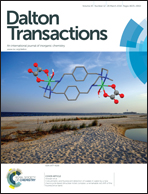Six [Tp*WS3Cu2]-based clusters derived from [Et4N][Tp*WS3], Cu(i) salts and phosphine ligands: syntheses, structures and enhanced third-order NLO properties†
Abstract
Treatment of [Et4N][Tp*WS3] (Tp* = hydridotris(3,5-dimethylpyrazol-1-yl)borate) (1) with CuX (X = Br, SCN) and PPh3 or 1,1-bis(diphenylphosphino)methane (dppm) produced two neutral trinuclear clusters [Tp*W(μ3-S)(μ-S)2Cu2Br(PPh3)] (2) and [Tp*W(μ3-S)(μ-S)2Cu2(SCN)(dppm)]2·MeCN·Et2O (3·MeCN·Et2O). Reactions of 1 with [Cu(MeCN)4]PF6, NH4PF6 and 1,3-bis(diphenylphosphino)propane (dppp), N,N-bi(diphenylphosphanylmethyl)-2-aminopyridine (bdppmapy), N,N,N′,N′-tetra(diphenylphosphanylmethyl)ethylenediamine (dppeda), or 1,4-N,N,N′,N′-tetra(diphenylphosphanylmethyl)benzenediamine (dpppda) afforded four clusters containing butterfly-shaped [Tp*WS3Cu2] cores, [Tp*W(μ3-S)(μ-S)2Cu2(dpppds)](PF6)·1.25MeCN (dpppds = 1,3-bis(diphenylphosphino)propane disulfide) (4·1.25MeCN), [Tp*W(μ3-S)(μ-S)2Cu2(bdppmapy)](PF6)·3MeCN (5·3MeCN) and {[Tp*W(μ3-S)(μ-S)2Cu2]2(L)]}(PF6)2·Sol (6·Et2O: L = dppeda, Sol = Et2O; 7·1.25MeCN: L = dpppda, Sol = 1.25MeCN). Compounds 2–7 were characterized by elemental analysis, IR, UV-Vis, 1H and 31P{1H} NMR spectra, electrospray ion mass spectra (ESI-MS) and single-crystal X-ray diffraction. Compound 2 or 3 has a butterfly-shaped [Tp*WS3Cu2] core in which one [Tp*WS3] unit binds two Cu(I) centers via one μ3-S and two μ-S atoms. In the cationic structure of 4 or 5, one in situ-formed dpppds or bdppmapy combines with the [Tp*WS3Cu2] core via each of its two S atoms or two P atoms coordinated at each Cu(I) center. In the bicationic structure of 6 or 7, two [Tp*WS3Cu2] cores are linked by one dppeda or dpppda bridge to form a bicyclic structure. The isolation of 2–7 with unstable [Tp*WS3Cu2] cores may be ascribed to the coordination of P- or S-donor ligands at Cu(I) centers of these cores. The third-order nonlinear optical (NLO) properties of 2–7 in DMF were also investigated by using the femtosecond degenerate four-wave mixing (DFWM) technique at 800 nm.
![Graphical abstract: Six [Tp*WS3Cu2]-based clusters derived from [Et4N][Tp*WS3], Cu(i) salts and phosphine ligands: syntheses, structures and enhanced third-order NLO properties](/en/Image/Get?imageInfo.ImageType=GA&imageInfo.ImageIdentifier.ManuscriptID=C3DT53320D&imageInfo.ImageIdentifier.Year=2014)

 Please wait while we load your content...
Please wait while we load your content...